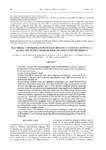Bacterial contamination of Kale (Brassica oleracea acephala) along the supply chain in Nairobi and its environment

View/
Date
2011-02Author
KUTTO, E. K.
NGIGI, M. W.
KARANJA, N.
KANGE’THE, E.
BEBORA, L. C.
LAGERKVIST, C. J.
MBUTHIA, P. G.
NJAGI, L. W.
OKELLO, J. J.
Metadata
Show full item recordAbstract
To assess the microbiological safety of kale (Brassica oleracea acephala) produced from farms and those sold at the markets with special focus on coliforms, e.coli and salmonella. Design: A cross sectional study. setting: Peri-Urban farms (in Athi River, Ngong and Wangige), wet markets (in Kawangware, Kangemi and Githurai), supermarkets and high-end specialty store both within Nairobi city. results: Mean coliform count on vegetables from farms were 2.6x105 ±5.0x105 cfu/g while those from the wet markets were 4.6x106 ±9.1x106 cfu/g, supermarkets, 2.6x106 ±2.7x106 and high-end specialty store 4.7x105 ±8.9x105. Coliform numbers obtained on kales from the wet markets and supermarkets were significantly higher (p<0.05) compared to those from farms, while kale samples purchased from high- end specialty store had similar levels of coliform loads as those from the farms. e. coli prevalence in the wet markets, supermarkets and high-end specialty store were: 40, 20 and 20%, respectively. salmonella was detected on 4.5 and 6.3% of samples collected from the farms in Wangige and wet market in Kawangware, respectively. Fecal coliforms in water used on farms (for irrigation) and in the markets (for washing the vegetables) exceeded levels recommended by World Health Organization (WHO) of 103 organisms per 100 milliliter while salmonella was detected in 12.5% of washing water samples collected from Kangemi market. conclusion: Poor cultivation practices and poor handling of vegetables along the supply chain could increase the risk of pathogen contamination thus puting the health of the public at risk, therefore good agricultural and handling practices should be observed
